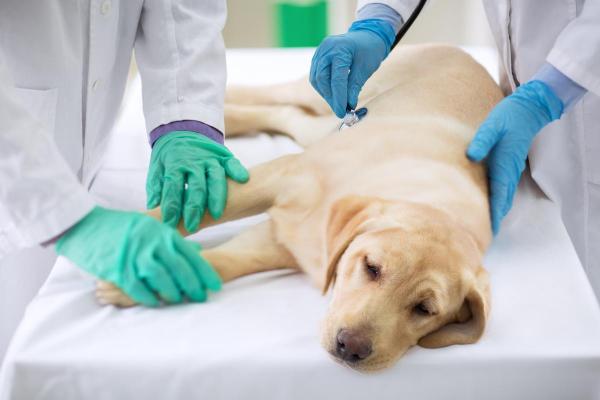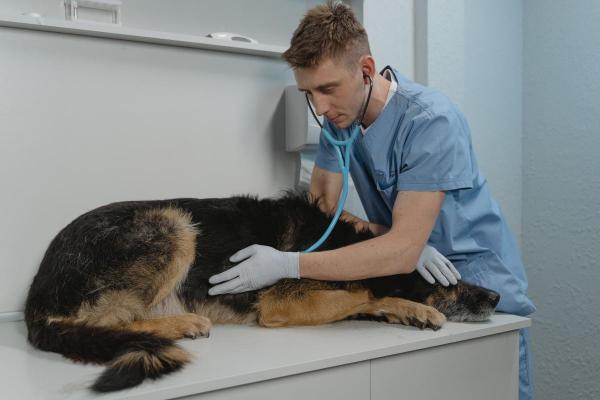My Dog Has a Tummy Ache



See files for Dogs
A tummy ache is a common symptom in dogs, but it is not always easy to observe. While it is often a sign of mild gastrointestinal upset, it is also a possible symptom of a more serious illness. This is especially the case if it persists for a prolonged period. Although an upset stomach is itself a symptom of an underlying health issue, we can see other signs which indicate the dog has a sore tummy. These can help us to identify digestive discomfort or alert us to a more serious problem which requires veterinary attention. These signs can be evident both in their physical bodies and their behavior. AnimalWised helps you to discern these symptoms in our article on my dog has a tummy ache.
Behavioral signs a dog has a tummy ache
When a dog has a tummy ache, their behavior can vary widely. Some dogs may not show much difference in comportment, even if they are in significant discomfort. Others can be overly sensitive with only mild digestive upset. Generally speaking, dogs are good at hiding signs of discomfort or pain. This means they can suppress symptoms of a tummy ache.
Other factors which determine the behavior of a dog with a tummy ache include the intensity of the pain, the presence of other clinical signs and whether the issue is acute or chronic. Some dogs may develop stomach issues which build over a prolonged time, resulting in more significant changes to their organism.
Whether chronic or acute, there are certain behavioral changes which likely suggest a dog has a sore tummy. They include the following:
- Loss of appetite
- Reduced energy
- Disinterest in normal activities
- Minimizing movement
- Listlessness or lethargy
- Vocalizations
- Breathing difficulties
As a result of the discomfort caused by a tummy ache, dogs often want to rest and be left alone. They may seek out their bed or another comfortable place where they can find some security. If the pain starts to become intense, they may let out vocalizations such as long moans. Changes to their breathing may be observed where the dog is panting with their mouth open.
Not eating or drinking for more than 24 hours can be very dangerous for a dog. This is especially the case for dogs which are otherwise vulnerable. Such vulnerability could be due to age, the presence of a preexisting condition or if they are undergoing high levels of stress. Dehydration can worsen symptoms and harm recovery, so it is very important we ensure the dog has enough fluids.
Discover other reasons why a dog loses their appetite with our article asking why is my dog not eating?
Physical signs a dog has a tummy ache
While behavioral symptoms can indicate the presence of a tummy ache in dogs, many of them are not exclusive to this issue. Loss of appetite or lethargy can also be representative of very serious health issues such as intoxication or different types of cancers. To help us discern if the issue is simply a tummy ache, there are numerous physical signs which are more specific to this disorder.
If a dog has an upset stomach or abdominal pain, we might observe the following symptoms:
- Swollen belly
- Borborygmus (abnormal bowel sounds)
- Gas buildup
- Stiff and hardened belly
Bloating can occur in both mild and severe cases of gastric upset. However, when a dog's belly is swollen and hard to the touch, it usually means sometimes serious is occurring. An example can be seen with gastric torsion in dogs whereby the stomach twists on its axis due to the buildup of gas. It is a life-threatening emergency which results in severe abdominal pain, panting, inability to vomit and other symptoms. It requires immediate veterinary treatment and surgery. Even with timely surgery, many dogs still die.
We learn more about serious cases of abdominal inflammation with our article on why a dog's stomach is in pain when you touch it.
Posture of a dog with a tummy aches
The posture your dog adopts is another sign they have a stomach ache. A dog with abdominal pain will often curl up in on themselves, adopting a hunched position. They may have difficulty getting comfortable for rest. Some dogs choose the so-called prayer position, with their front legs extended on the ground and their belly elevated.

Gastrointestinal symptoms a dog has a tummy ache
We have already explained that a tummy ache can be acute or chronic, as well as being a symptom of illnesses which vary greatly in terms of severity. Since the stomach is part of the gastrointestinal system, it is often accompanied by symptoms of gastrointestinal distress.
In addition to the physical and behavioral signs of a tummy ache in dogs we have provided above, there are some specific symptoms which affect the digestive system. They include the following:
- Vomiting
- Constipation
- Diarrhea
- Soft stools
Both vomiting and diarrhea can vary in type, texture and color. The type of diarrhea in dogs can help a veterinarian make a diagnosis. For example, it may contain blood, foreign bodies or signs of parasitical infestation, in addition to changes to color, consistency and odor. We should take note of any such changes and report them to the veterinarian when we take them for examination.
In addition to the above gastrointestinal signs, we may see the dog becoming restless or nauseous due to digestive discomfort. They won't always vomit, but it is common to see the dog gagging as if they were about to.
Differences in color and consistency of vomit can also indicate specific causes, such as the dog throwing up green bile or vomiting white foam instead.

When to take a dog with a tummy ache to the veterinarian
With some of the symptoms of a tummy ache in a dog, we don't need to be overly concerned. A little gastric upset may pass quickly and the dog will be back to normal without any intervention. In these cases, the problem may be a result of eating something that didn't agree with them. In many cases, the exact cause will be idiopathic.
Other symptoms of a tummy ache can be much more worrying. This is especially the case with behavioral symptoms such as lethargy since it implies their organism is severely affected. Even if minor symptoms are prolonged, we should take them to a veterinarian. Generally speaking, if symptoms such as vomiting and/or diarrhea in the dog persist for more than 24 to 48 hours, you will need to speak to a professional.
We need to be particularly careful with certain dogs. Puppies have not yet developed a sturdy immune system, so causes of a tummy ache can pose more significant danger. Senior dogs may be made more vulnerable thanks to wear and tear over time. Some dogs may have preexisting conditions such as immunodeficiency diseases which can make them more vulnerable. In these cases, we should exercise more caution.
Under no circumstances should we medicate our dog ourselves. This could worsen the situation, delay diagnosis and even lead to a fatal outcome. Some of our commonly used over-the-counter medications are toxic to dogs, so giving human medicine to dogs should be avoided without strict guidelines by the veterinarian.
You can learn about a common issue which results in tummy ache in dogs with our article asking can dogs digest bones?

This article is purely informative. AnimalWised does not have the authority to prescribe any veterinary treatment or create a diagnosis. We invite you to take your pet to the veterinarian if they are suffering from any condition or pain.
If you want to read similar articles to My Dog Has a Tummy Ache, we recommend you visit our Intestinal problems category.
- Carlson & Giffin. (2002): Practical manual of canine veterinary medicine. Madrid: Editorial El Drac.







